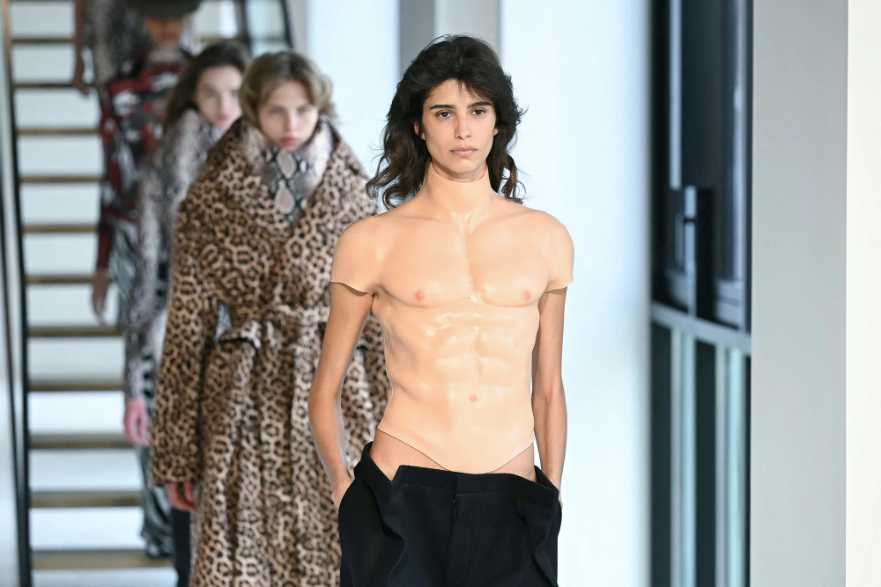For his Fall-Winter 2025 show at Paris Fashion Week, Dutch designer Duran Lantink continued to break the mold with his offbeat designs. Set in an office space that wouldn’t look out of place in the science fiction thriller “Severance,” the collection featured silhouettes with warped proportions, as well as eye-catching styles that included zany animal prints and butt-revealing jeans.
But it was two prosthetic torsos that stole the show. First, was a chiseled six-pack sported by model Mica Argañaraz. Then came the buxom climax: Chandler Frye, an emerging male model, wore a pair of big, bouncing breasts.
Videos of Lantink’s outrageous antics racked up millions of views on social media as commenters argued over whether it championed gender-fluidity or ridiculed femininity. For Lantink, it was about toying with the idea of humans as dolls. “I love the idea of women as action figures,” he wrote in the show notes.
Perhaps so, but it also tapped into a growing trend on the runways: prosthetics. In recent seasons, fashion brands including Martine Rose, Collina Strada and Balenciaga have used implants, masks and 3D makeup techniques to transform models into animals, aliens and cyborgs. Most memorably, Stockholm-based fashion label Avavav, known for its madcap latex creations, made a wearable replica of Kim Kardashian’s backside out of silicone.
“(Designers are using) prosthetics to challenge beauty norms and explore transformation and identity, creating a broader cultural narrative,” said Tanya Noor, a course leader of the Hair, Makeup and Prosthetics for Performance undergraduate program at London College of Fashion, over an email.
Striking, lifelike results
The oldest known medical prosthetics (two artificial toes) date back to ancient Egypt, where they were used as walking aids. Approximately 300 years later, in 300BC, came the first known prosthetic leg; made from bronze and wood, it was thought to have been worn by a Roman nobleman. Following the American Civil War in 1860, more advanced wooden limbs with rubber cushioning were created to meet the needs of new amputees.
Then, prosthetics were adopted for the purpose of art and entertainment. At the dawn of cinema, in 1895, prosthetics were created through a crude concoction of materials including gum, cotton and wax. By the 1930s, the invention of foam latex saw rubber masks become commercially available for the first time thanks to prop maker Don Post, earning him the moniker “The Godfather of Halloween.” For the first time, lifelike faces were readily available for both performers and punters. Elsewhere, prosthetics came to play a key role in the art form of drag, where performers use prosthetic breastplates and hip pads to show varying forms of femininity.
Today, the results are more striking than ever: the 2024 horror film “The Substance” won an Oscar for the prosthetics worn by actors Demi Moore and Margaret Qualley to achieve visceral looks (though Qualley later revealed that the prosthetics caused her skin damage that took a year to recover).
They’ve become a bigger part of red carpet fashion, too. Malina Stearns, a special effects makeup artist, masterminded Doja Cat’s look at the 2023 Met Gala, where the popstar embodied Karl Lagerfeld’s beloved cat in a custom Oscar de la Renta gown and facial prosthetics. Stearns has also worked with musicians on other creations including the alien that featured in Sabrina Carpenter’s 2024 VMAs performance, SZA’s bug-eyed album cover and the crocodile-inspired cheeks and chest pieces worn by Doechii.
Lantink isn’t the only one to use prosthetics to subvert gender norms, either. “I’ve applied many fake boobs to men and vice versa,” Stearns said, over email.












Leave a Reply